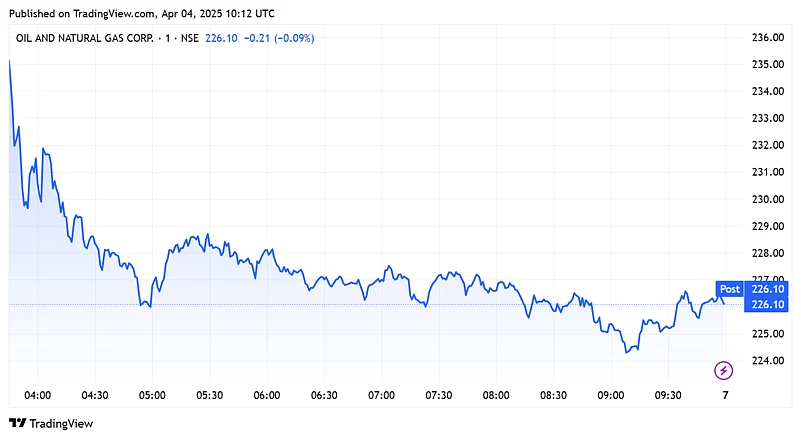Oil price: Unexpected moves in the geopolitical sphere seem to have become the new trend. Just when everyone thought that the worst was over for domestic OMC stocks, the Organisation of Petroleum Exporting Countries (OPEC) announced a surprise move to increase oil output. This eventually pushed the price of crude oil prices below the $70 per barrel mark. MCX Crude Oil's April 2025 contract followed cues and plummeted by 7.18% in a single session, closing at Rs 5,735.
Major oil stocks, including ONGC, Oil India and IOC, fell by up to 7% on April 4. For upstream oil companies, the downtrend was sharp as the threat of lower oil prices was already lingering in the picture.

At 01:40, shares of ONGC were trading at Rs 226 price level, down by around 6.81% on the National Stock Exchange.
Earlier the OPEC group had planned to increase the overall output by 1.38 million barrels per day in May. However, they have revised the figure to a whopping 4.11 million barrels per day. This is expected to weigh down the cost of black gold, putting pressure on the bottom lines of major OMCs.
Why did OPEC hike oil production?
OPEC, with its large market share, has traditionally held an upper hand in influencing oil prices. But that grip has loosened a bit, especially with Trump tariffs now in the picture. Many were expecting the OPEC group to provide support to crude oil prices. However, things took a completely different turn as the coalition of oil producers announced a sharp production hike.
As per reports, this move was a deliberate effort to drive down oil prices and create pressure on nations like Kazakhstan and Iraq, who exceeded their production quotas. The Saudi Energy Minister Prince Abdulaziz bin Salman even warned that this output hike was just an "aperitif", signalling more aggressive actions ahead. Post the announcement, crude witnessed the biggest single-day decline since July 2022 with West Texas Intermediate (WTI) falling by 6.6%, slipping below $67.
Is it 'really' a red flag for OMCs?
Domestic oil companies are already experiencing stumbling blocks, from low oil prices squeezing into margin levels to inventory gains taking a hit. On top of that, some OMCs are also dealing with project delays. The subdued sentiment was also visible in stock performance. So far this year, the Nifty Oil & Gas index has declined by over 6%.
Lower oil prices usually hurt upstream companies like Oil India and ONGC by complicating their margin play. If global oil prices fall before they process and sell that crude, they end up selling finished products at lower prices than the cost at which they procured the crude, leading to inventory losses.
However, analysts remain somewhat positive on upstream companies. This is majorly owing to policy relief provided by the government.
A few months back, the Centre scrapped the windfall tax on domestically produced crude oil, including diesel, petrol and aviation turbine fuel (ATF). Even the ORD (Oilfields Regulation and Development) Act brings more policy/fiscal stability, as per analysts. As for OMCs, as long as the government does not implement a simultaneous reduction in petrol/diesel prices in response to crude, the margin play might remain strong.
"With retail prices frozen, the lower oil prices are optically positive for OMCs. However, some of this positive impact will be offset by rising US oil supplies, declining Russian crude and a weak INR. There remains a strong case to cut/free-up retail prices," Kotak Securities stated in a report. While the brokerage house has downgraded earnings for upstream companies, it has maintained a BUY rating on ONGC and SELL on Oil India.

































